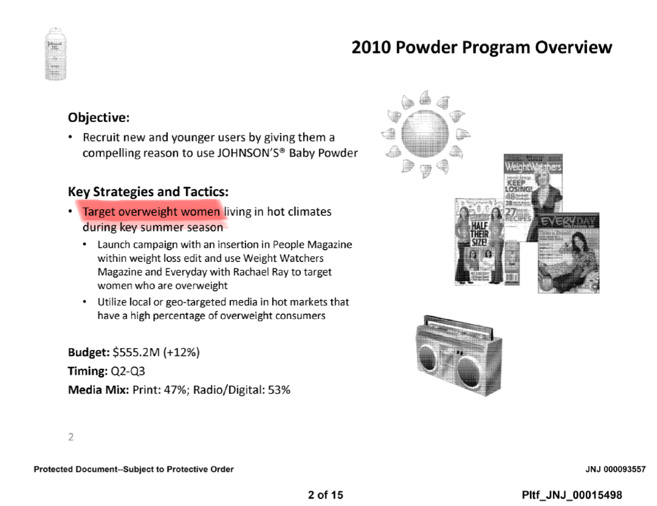
"A Decades-Long Cover Up: Profits above Women's Lives and Lies Before truth."
Internal documents spanning at least 40 years show a paper trail by J&J that outlines that not only was the company aware that their talc-based products had tested positive for asbestos, but that they actively covered up negative results, limited sample sizes for tests, and instead focused on “neutralizing” outside testing results of asbestos in their products as well as launching ad campaigns directed to African American, Hispanic, and overweight women.
A look at several known J&J tests has proven that asbestos concerns were flagged in Johnson’s Baby Powder and in J&J’s Shower to Shower products. Further, in 1997, a J&J consultant wrote a memo to warn them of their “insufficient” response to the connection of talc to cancer, pointing out that at “that time there had been about 9 studies (more by now) published in the open literature that did show a statistically significant association between hygienic talc use and ovarian cancer,” and going so far as to warn them of “denying the obvious in the face of all evidence to the contrary.

A 1973 internal memo outlined the following guidelines for countering negative research about the health effects of talc:
“Our current posture with respect to the sponsorship of talc safety studies has been to initiate studies only as dictated by confrontation,” the memo said. “This philosophy, so far, has allowed us to neutralize or hold in check data already generated by investigators who question the safety of talc.”
“J&J didn’t tell the FDA about a 1974 test by a professor at Dartmouth College in New Hampshire that turned up asbestos in talc from J&J – “fiberform” actinolite, as he put it. Nor did the company tell the FDA about a 1975 report from its longtime lab that found particles identified as “asbestos fibers” in five of 17 samples of talc from the chief source mine for Baby Powder. “Some of them seem rather high,” the private lab wrote in its cover letter.”
(Reuters, 12/17/18)
J&J Targeted African American, Hispanic, and Overweight Women
When negative publicity about the connection of talc and asbestos to cancer arose in the early ’90’s that resulted in the drop in sales, an internal J&J memo from 1992 outlines their strategy for “Major Opportunities” that included making up the difference by targeting African American, Hispanic, and overweight women. A later ad campaign shows how J&J targeted overweight consumers in hot climates during “key summer season.”


Asbestos is a Known Cause of Cancer
Since the early 1970s, it has been common knowledge that asbestos — which is mined near and alongside talc— is a primary cause of cancer (mesothelioma). As a result, regulations went into effect to protect workers in industries that historically interacted with asbestos.
However, it did not explain how people with no obvious connection to these environments could be exposed to asbestos, and researchers began to explore potential factors. With talc being mined alongside and near the same geological environments as asbestos, scientists tested talc-based products.
J&J Destroyed Thousands Of Lives
The Federal Drug Administration’s guidelines on labeling potentially harmful products state: “The label of a cosmetic product shall bear a warning statement whenever appropriate to prevent a health hazard that may be associated with the product.” With even these minimal guidelines, it is clear that J&J is in violation.
The American public, especially women, trusted J&J to protect their health, but J&J did the opposite. They knowingly poisoned women and destroyed lives with their asbestos contaminated baby powder. J&J should aggressively remove all talc-based products from shelves, NOW! It’s time for everyone to ask: Can we TRUST J&J with our health?

